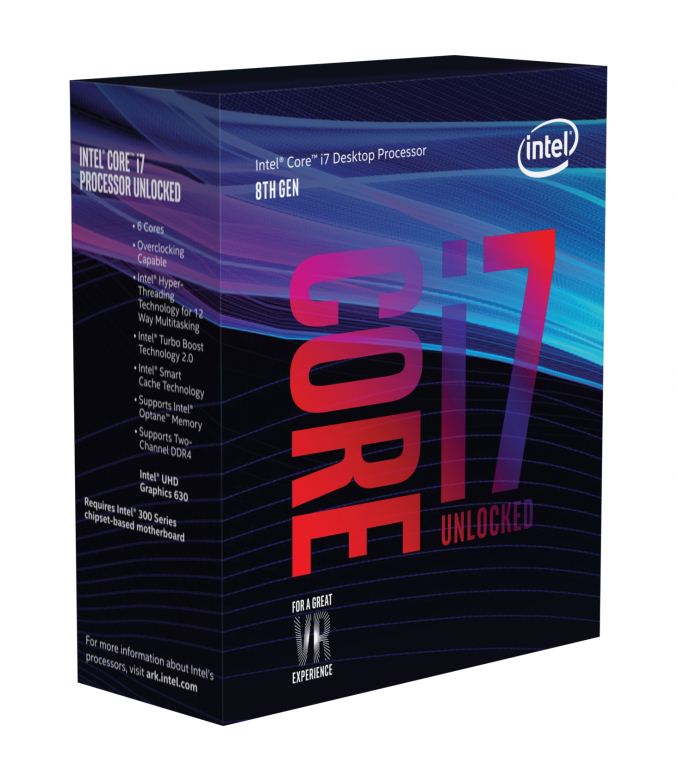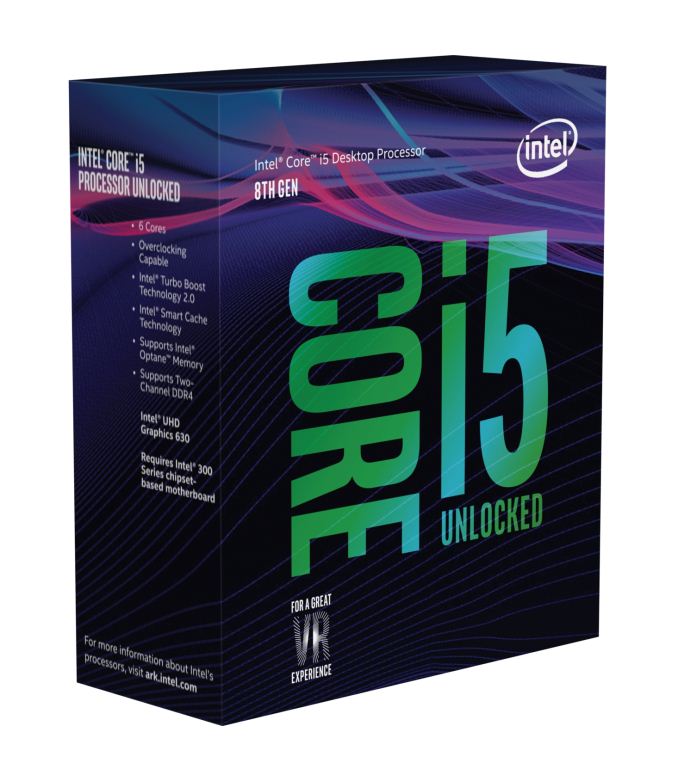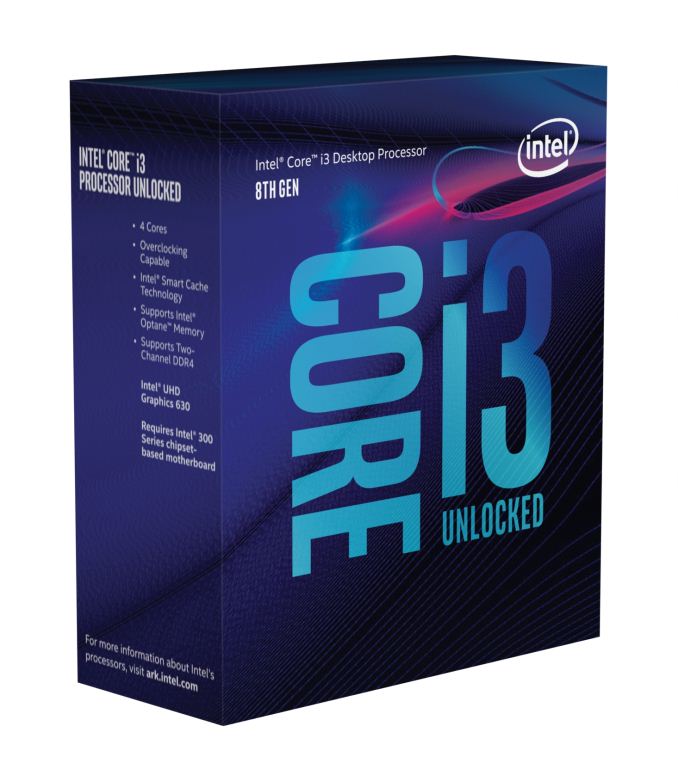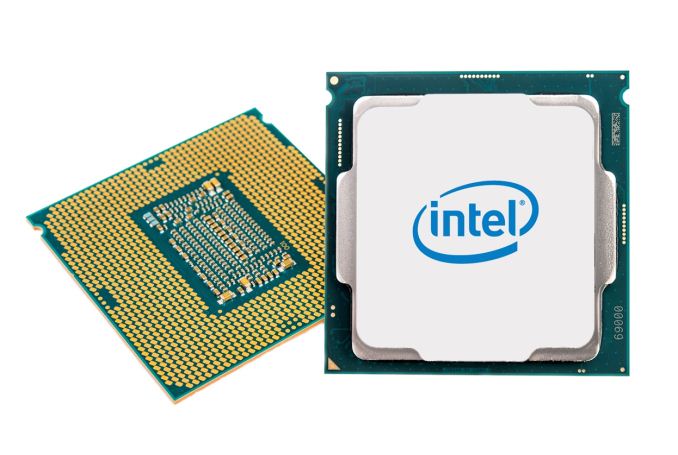The AnandTech Coffee Lake Review: Initial Numbers on the Core i7-8700K and Core i5-8400
by Ian Cutress on October 5, 2017 9:00 AM EST- Posted in
- CPUs
- Intel
- Core i5
- Core i7
- Core i3
- 14nm
- Coffee Lake
- 14++
- Hex-Core
- Hyperthreading
Intel Coffee Lake Conclusion
It has been a long time coming, but we finally have something bigger than a quad-core processor on Intel’s mainstream platform. Fundamentally it might be the same architecture as the processors preceded it, but after a decade of quad-core Intel parts, it comes as a welcome improvement. Intel sampled us the Core i7-8700K and the Core i5-8400 for this set of initial launch testing, with the goal of offering more high performance cores at more mainstream price points without having to invest in the company's more expensive and otherwise more complex HEDT platforms.
The Core i7-8700K
The Core i7-8700K in our testing was designed to be the new halo mainstream processor: many cores and the highest frequencies seen on an Intel part out of the box, with the option of overclocking thrown in. With a peak turbo frequency of 4.7 GHz, in benchmarks that could be stripped down to a single core with no other work going on, the i7-8700K took home the bacon.
The problem here is the same problem we’ve seen with big core parts and Windows 10, however: these large processors can only take so much before having to move threads around, to keep both the frequency high and the energy density low. All it takes is for a minor internal OS blip and single-threaded performance begins to diminish. Windows 10 famously kicks in a few unwanted instruction streams when you are not looking, and as a result the CPU fires up another CPU core and drops to a lower turbo bin. Consequently the average single thread performance seen on the 8700K might be equal or lower than that of the previous generation. It becomes an infuriating problem to debug as a reviewer.
Nonetheless, when software needs to take advantage of the cores, the Core i7-8700K will run through at an all-core turbo frequency of 4.3 GHz, consuming about 86W in the process. The jump up from a quad-core to a hex-core for only a $20 difference will be immediately noticeable in the software that can take advantage of it.
What is interesting to note is that the Core i7-8700K essentially kills the short-lived Kaby Lake-X parts on the X299 high-end desktop platform. Again, for a few extra dollars on the 8700K, a user can save over $100 on the motherboard, get more cores and more performance, and not have the hassle of dealing with a hybrid X299 platform. It does make me wonder why Intel released Kaby Lake-X in the first place, if they knew just how short lived they would be.
When comparing against the Core i7-7800X, a high-end desktop part at a similar price and with the same core count but a lower frequency, it really comes down to what the user needs. Performance easily favors the Core i7-8700K, however that cannot replace the quad-channel memory (up to 128GB) and the 28 PCIe lanes that the Core i7-7800X can support. In most circumstances, especially gaming, the Core i7-8700K will win out.
Intel’s 8th Generation CPUs: The Ones To Watch
Intel also sampled us the Core i5-8400, showing that six-core processors can cost less than $200. This processor, along with the Core i3-8100, will form the new backbone of general computing when using Intel components: the Core i3-8100 replaces old Core i5 processors for around $120, and enthusiasts who simply want a little more oomph can go with the Core i5-8400 at $190 at retail. It almost comes across as adding 50% cost for adding 50% performance. Personally I think the Core i3-8100, if made widely available, will be a top-selling processor for casual desktop users and gamers who were previously looking for a good performance-per-dollar part.
There is one other comparison to note: the Core i5-8600K and the Core i7-8700. These two parts are $50 apart, however the Core i7-8700 has double the threads, +10% raw frequency, 33% more L3 cache, and 1/3 lower TDP. The Core i5-8600K has overclocking, however going up to the i7 ensures stability, and should offer more raw performance. It will be interesting to get these two in to test, and especially to see if the TDP rating makes a significant performance difference.
Today’s Review Takeaway
We finally have six-core processors on Intel’s mainstream platform, which has driven up the core counts (and frequencies) of the company's low and mid-range processors. For anyone looking at building a system in the last 6-12 months, they should be able to build an equivalent with the latest-generation processor for $50-$100 less. Or spend the same and get a few more cores to play with. The last time we had this situation was a decade ago, and hopefully it won’t take another decade to happen again.
Dedicated reviews for the processors (with more gaming tests) are on the cards. Stay tuned!















222 Comments
View All Comments
Zingam - Saturday, October 7, 2017 - link
Not everybody has a rich daddy! Performance per dollar matters in all areas of life!It doesn't matter to very, very rich people or sucker fanboys!
mapesdhs - Monday, October 9, 2017 - link
Again the myth that rich people don't care about wasting money. So wrong. :D As for fanboyism, that kind of label gets hurled in both directions, but IRL has little meaning.Gothmoth - Thursday, October 5, 2017 - link
an overlcocked ryzen 1700 is bit for bit the best choice.. still.except for hardcore gamers.
and i bet intel paid you quite a bit to ignore stuff other (less intel biased) reviewers pointed out today.
mkaibear - Thursday, October 5, 2017 - link
Ryzen has no integrated GPU so it can't be the best choice for anyone without a discrete GPU (aka the vast majority of the market - about 70% as per q1 2017). Ironically the gamers are the ones more likely to snap up Ryzen as they have discrete graphics cards anyway...Ananke - Thursday, October 5, 2017 - link
I see the same, ryzen 1700 remains the best buy, followed by ryzen 1600, which recent batches seems to have 8 cores instead of 6, for around $170. They do come with heatsink, another $30 saved. With ok board it will total $250. Even better, readily built Dell gaming desktops can achieve around $800 with r580 8gb and 16 GB ram with 1700 ryzen vs above $1100 for similar Intel. It is literally no brainer choiceGastec - Saturday, October 14, 2017 - link
Wow there, rewind! "Ryzen 1600, which recent batches seems to have 8 cores instead of 6". Care to explain more?Ryan Smith - Thursday, October 5, 2017 - link
"and i bet intel paid you quite a bit to ignore stuff other (less intel biased) reviewers pointed out today."You'd lose that bet.
Now since we're apparently doing this Jeopardy style, please tell me how much you wagered so that I know how much I'm collecting. Since Intel isn't paying me, you will have to do. ;-)
In all seriousness though, taking sides and taking bribes would be a terrible way to run a business. Trust is everything, so losing the trust of you guys (the readers) would be about the worst possible thing we could do.
FourEyedGeek - Saturday, October 7, 2017 - link
Are you happy for an overclocked Ryzen 1700 to be compared against overclocked Intel processors as well?gnufied - Thursday, October 5, 2017 - link
Your bench pages are either loading very slowly or displaying Gateway timeout.Ryan Smith - Thursday, October 5, 2017 - link
Thanks. Having the server team look into it.